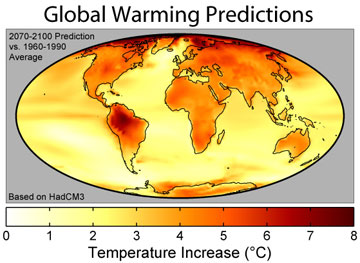Past climate change may have fried rainforests
Past climate change may have fried rainforests
From icehouse to hothouse: Melting ice and rising CO2 caused climate shift
University of Michigan
February 18, 2007
Three hundred million years ago, Earth’s climate shifted dramatically from icehouse to hothouse, with major environmental consequences. That shift was the result of both rising atmospheric carbon dioxide concentrations and the melting of vast ice sheets, new research by University of Michigan paleoclimatologist Christopher Poulsen shows.
Poulsen will discuss his findings in a symposium titled “Geosystems: Climate Lessons from Earth’s Last Great Icehouse” at the annual meeting of the American Association for the Advancement of Science in San Francisco.
The changes occurred during the period of Earth’s history when the continents were consolidated into a single supercontinent, Pangaea. Toward the end of the Paleozoic Era, tropical regions of Pangaea became much warmer and drier, winds in the region shifted direction, and tropical flora drastically changed. At the same time, atmospheric carbon dioxide increased and the enormous ice sheets that blanketed Gondwana–the landmass that eventually broke up to become present-day South America, Africa, Antarctica, India and Australia–began disappearing.
 This figure shows the predicted distribution of temperature change due to global warming from the Hadley Centre HadCM3 climate model. This figure was prepared by Robert A. Rohde from publicly available data and is available at globalwarmingart.com. RELATED ARTICLES Dinosaurs survived rapid climate change Past global warming suggests massive temperature shift in our future |
“There’s lots of evidence for large changes in climate and vegetation, but there’s been no clear hypothesis for why those changes occurred,” said Poulsen, who is an assistant professor of geological sciences. A few notions have been floating around: some researchers have suggested that the uplifting or erosion of mountain chains might have caused the climate shift; others think the motion of the plates that make up Earth’s outer layer played a role. But Poulsen had a different idea. “I wondered whether the melting of the Gondwana ice sheets and/or the rise in atmospheric carbon dioxide could explain these documented climate and vegetation changes,” he said.
Poulsen and coworkers used theoretical climate models to experiment with different combinations of carbon dioxide concentrations and glaciation.
“The modeling simulations showed that as Gondwana deglaciated and carbon dioxide rose, the tropics became more arid and the vegetation was fried and replaced with desert,” Poulsen said. “Our results also showed that deglaciation and rising carbon dioxide contributed about equally to the observed climate and vegetation changes.”
In addition, the model, which relied on estimates of carbon dioxide concentrations, produced more warming than geological evidence actually indicates. This may suggest that carbon dioxide didn’t rise quite as much as has been estimated, Poulsen said.
Poulsen is cautious about applying his conclusions to current climate concerns.
“The climate change I’m studying happened a long time ago, so you have to be a little careful, but certainly this work shows there is a very strong connection between carbon dioxide increase and warming,” he said. “Another interesting aspect is that for a long time people have thought that the tropics aren’t really susceptible to large climate changes. This work shows that the tropics are susceptible.”
This is a modified news release, titled “From icehouse to hothouse: Melting ice and rising CO2 caused climate shift”, from the University of Michigan.